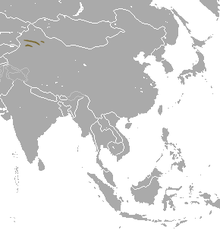Ili pika
| Ili pika | |
|---|---|
| Scientific classification | |
| Kingdom: | Animalia |
| Phylum: | Chordata |
| Class: | Mammalia |
| Order: | Lagomorpha |
| Family: | Ochotonidae |
| Genus: | Ochotona |
| Species: | O. iliensis
|
| Binomial name | |
| Ochotona iliensis Li & Ma, 1986
| |

| |
| Ili pika range | |
The Ili pika (Ochotona iliensis) is a species of mammal in the family Ochotonidae, endemic to northwest China. After its discovery in 1983, it was not documented again until 2014[citation needed]. The Ili pika population is declining and is currently considered to be endangered, with approximately fewer than 1,000 left.[2]
Description[]
The Ili pika somewhat resembles a short-eared rabbit. It is large for a pika, with a length of 20.3–20.4 cm (~8") and a weight of up to 250g (~1/2 lb). It has brightly colored hair and displays large rusty-red spots on forehead, crown, and the sides of the neck.[3][4]
Range[]
It is endemic to the Tian Shan mountains of northwest Chinese province Xinjiang. A recent census indicated that the Ili pika may have been extirpated from the Jilimalale and Hutubi South Mountains.[3]
Ecology[]
The Ili pika inhabits talus slopes at high elevations, usually from about 2,800 to 4,100 meters.[5] This species constructs haypiles and is a generalized herbivore.[3] It primarily feeds on grasses and herbs.[5]
Almost nothing is known about the ecology or behavior of the species.[6] The Ili pika has low population densities. It is mostly a diurnal species[citation needed], but may exhibit nocturnal activity. Only one to two litters are produced each year, but litter size for this species is unknown.[3] The Ili pika is similar to other rock-dwelling pikas in that they are asocial creatures[citation needed], however, they are less likely to utter vocalizations[citation needed]. Also, the Ili pika varies the percent of time it is active during the day or night based on seasons. During the winter season, they are more active during the day while during the spring and fall, they are more active at night.[7]
Conservation[]
The species was first observed by conservationist Li Weidong in 1983. After three years of research, Li and his team named it the Ili pika, after the area where it is found, the Ili Prefecture on the far west side of China's Xinjiang province.[8] The animal was not documented again until May 2014 (again by Li). Up to 2015, a total of 29 live sightings were reported.[5]
Its population has been reduced by 70% within 15 years. Population declines have been observed for several locations inhabited by this species. A recent census indicated that the Ili pika may have been extirpated from the Jilimalale and Hutubi South Mountains. Populations have declined in the regions of Jipuk, Tianger Apex, and Telimani Daban. Only one examined site, the Bayingou region of Xinjiang Uygur, showed signs of previously observed abundance. An estimated 2,000 mature individuals existed in the early 1990s.[3] The exact causes for recently observed population declines are not known with certainty, but it is speculated that an increase in grazing pressure and global atmospheric pollution resulting in climate change are negatively affecting populations. It has been suggested that a warming climate has increased the presence of vegetation and animal species from lower elevations in the pika's habitat, leading to a larger number of attendant predators (e.g. foxes) to which pika populations had not so far been exposed.[9] Low population densities and reproductive rates coupled with the relatively limited ability to disperse impede the ability of the species to recover from declines. One study of captive animals suggests that the species has some capacity to adapt its feeding habits to lower elevations.[10] There are no known conservation measures in place for the Ili pika.[3]
See also[]
References[]
- ^ Li, W.; Smith, A.T. (2019). "Ochotona iliensis". The IUCN Red List of Threatened Species. 2019: e.T15050A45179204. doi:10.2305/IUCN.UK.2019-1.RLTS.T15050A45179204.en.
- ^ "12 rare animals that are teetering on the brink of extinction". Business Insider. Retrieved 2018-03-15.
- ^ Jump up to: a b c d e f Li, W.; Smith, A.T. (2005). "Dramatic decline of the threatened Ili pika Ochotona iliensis (Lagomorpha: Ochotonidae) in Xinjiang, China". Oryx. 39: 30–34. doi:10.1017/s0030605305000062.
- ^ Smith, A.T. & Xie, Y. (2008). The Mammals of China. Princeton University Press, Princeton, New Jersey.
- ^ Jump up to: a b c "Unbelievably Cute Mammal With Teddy Bear Face Rediscovered". National Geographic. 2015-03-19.
- ^ Smith, A.T. & Xie, Y. (1990). "Chapter 3: The Pikas". In J. A. Chapman & J. C. Flux (eds.). Rabbits, Hares and Pikas: Status Survey and Conservation Action Plan. The World Conservation Union, Gland, Switzerland.
- ^ Li, W., & Smith, A. T. (2015). In search of the illusive and iconic Ili pika (Ochotona iliensis). MOuNTAIN VIEWS, 21.
- ^ Li, W.; Ma, Y. (1986). "A new species of Ochotona, Ochotonidae, Lagomorpha". Acta Zoologica Sinica. 32: 375–379.
- ^ Kevin Krajick (2004). "All Downhill From Here?". Science. 303 (5664): 1600–1602. doi:10.1126/science.303.5664.1600. JSTOR 3836425. PMID 15016975. S2CID 140164420.
- ^ Wei-dong, L. (1994). "A Preliminary Research on the Artificial Feeding of Ili Pika". Chinese Journul of Vector Biology and Contral. 2.
External links[]
- IUCN Red List endangered species
- Mammals of China
- Pikas
- Mammals described in 1986
- Endemic fauna of China
